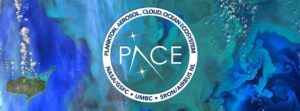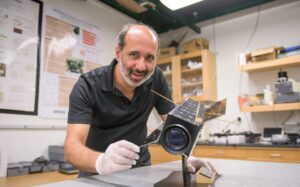Introduction to NASA’s Plankton, Aerosol, Clouds, ocean Ecosystem (PACE) mission
Time: Every Thursday 1pm
Location: Physics Building of UMBC (in-person)
WebEx Meeting link:
https://umbc.webex.com/umbc/j.php?MTID=m248e1357c0e522374a8c4f0e51e9b329
Meeting number:
2634 315 0501Meeting password:
GESTAR2-PACEJoin from a video or application
Dial 26343150501@umbc.webex.com
You can also dial 173.243.2.68 and enter your meeting number.


Dr. Jeremy Werdell (he/him)
Project Scientist of the PACE Mission
1PM Thursday Feb. 15th, 2024
In-person: Physics Building 401
Keeping PACE with the NASA Plankton, Aerosol, Cloud, ocean Ecosystem (PACE) mission

Dr. J. Vanderlei Martins
Professor, Physics Department, UMBC
Director, Earth and Space Institute, UMBC
1PM Thursday Feb. 22nd, 2024
In-person: Physics Building 401
Polarization measurements of aerosols and clouds from HARP Cubesat to HARP2 and beyond.

Dr. Amir Ibrahim
Ocean Ecology Lab (OEL) NASA GSFC
1PM Thursday Feb. 29th, 2024
Virtual only
An Insight into the PACE Mission and the Expected Performance for Ocean Color Observations
With the successful launch of NASA’s Plankton, Aerosol, Cloud, ocean Ecosystem (PACE) mission on February 8, 2024, PACE has become the most advanced satellite for measuring ocean color from space. The primary instrument aboard PACE is the Ocean Color Instrument (OCI), a hyperspectral radiometer that captures top-of-atmosphere light across nearly 300 different wavelengths, ranging from UV to shortwave infrared. Additionally, PACE carries two contributed polarimeters: HARP2 from UMBC and SpexOne from SRON. These multi-angular polarimeters are specifically designed for the observation of clouds and aerosols, offering potential enhancements for ocean color measurement.
In this presentation, we will offer an overview of the PACE mission and provide insights into how PACE scientists collaborated with engineers at Goddard to develop the OCI. This process involved conducting trade studies, evaluating the radiometric performance of the instrument, and assessing its impact on scientific products through a series of realistic geophysical simulations. We will also detail the atmospheric correction algorithm employed at launch to accurately observe ocean color from space.

Dr. Otto Hasekamp
Scientist at Netherlands Institute for Space Research (SRON)
1PM March 7th, 2024
Virtual only
The SPEXone Aerosol Polarimeter for the NASA PACE Mission
SPEXone is a Multi-Angle Polarimeter (MAP) that is part of the NASA Plankton, Aerosol, Cloud & ocean Ecosystem (PACE) mission, launched on February 8 2024. The instrument provides hyperspectral radiance and polarization measurements at high accuracy in the spectral range 385-770 nm observing each ground pixel under 5 viewing angles. SPEXone has been developed, built, and calibrated in the Netherlands by a consortium of SRON Netherlands Institute for Space research and Airbus Netherlands B.V.. The scientific lead and data processing algorithm development is in hands of SRON. SPEXone will deliver unprecedented information on a.o. aerosol absorption (SSA), aerosol amount (AOD, number column), aerosol type (through complex refractive index and particle shape) size distribution, and aerosol layer height. These measurements, together with the other instruments on PACE, will bring important new pieces of information to better quantify the cooling effect on climate due to aerosol-radiation interactions (ARI) and aerosol-cloud interactions (ACI). This presentation will cover the different aspects of the development of SPEXone: Science case, instrument concept, calibration, data processing, and scientific data use.

Dr. Lorraine Remer
Deputy Lead and PI NASA PACESAT
Manager UMBC HARP2
Collaborator NASA PACE Val Team
PI NASA IDS Study
1PM March 14th, 2024
Hybrid
The distinction between the four PACE science teams: Lorraine explains it all to you
During the first half of this very comprehensive seminar series you have been presented with several speakers, each presenting different aspects of the mission. All of these presentations, so far, represent different aspects of PACE PROJECT Science. Do you realize that PACE PROJECT Science is supplemented by THREE other NASA-supported science teams? These are the PACE Science and pplication Team (PACESAT), the PACE Validation Team and recently announced in ROSES 2024, the Science of PACE. Although there is overlap, the four teams pursue different aspects of PACE science. I have had opportunity to participate in three
of the four teams, and also am pursuing a science-driven project that lends itself easily to the fourth. In this seminar I will describe the distinction between the four teams, but also present my own work in the PACESAT to create an advance algorithm for aerosol characterization from OCI observations, my participation as a collaborator with the PACE Validation team to validate this product, and the work I have been leading on atmospheric nourishment of ocean ecosystems as an example of the potential for the Science of PACE.

Dr. Brent McBride
Research Scientist at ESI
1PM March 28th, 2024
Hybrid
The PACE Data Access and Usage
In the seminar, he will provide an overview of the HARP-2/PACE instrument characteristics, followed by a live demonstration of PACE data access and usage using Google CoLab.
Link to Google Colab script:
https://colab.research.google.com/drive/1CwOiU59v0Sg0xFKgEulQZRk2q9jQ-w1_?usp=sharing
Link to Recorded Video:
https://drive.google.com/file/d/1klrfspCb00z5v1Gz9m2PkjfQqG9iY4ZX/view?usp=sharing

Dr. Bastiaan van Diedenhoven
SRON Netherlands Institute for Space Research
1PM April 4th, 2024
Virtual only
Clouds strongly affect the incoming and outgoing radiation at the Earth surface and therewith the temperature. The sensitivity of cloud properties to changes in the climate and to anthropogenic aerosol emissions are highly uncertain, which in turn leads to uncertainties in projected future climate. Better, global cloud observations are needed to advance our knowledge on cloud processes. In this talk I will give an overview of the cloud products that are provided by NASA’s Plankton, Aerosol, Cloud, ocean Ecosystem (PACE) mission, which was launched on 8 February 2024. PACE caries the Ocean Color Instrument (OCI), the Hyper-angular Rainbow Polarimeter (HARP-2) and the Spectropolarimeter for Planetary Exploration (SPEXone). Here, I will especially focus on the advanced cloud products that will be produced from observations by the polarimeters and their combinations with OCI, including cloud top phase, droplet number concentrations, droplet size distributions and ice crystals shape and scattering properties. Additionally, I will discuss how the PACE cloud products will be validated using the PACE-PAX field campaign. Finally, I will discuss plans to use the PACE mission to advance our understanding of cloud processes and remote sensing.

Dr. Ivona Cetinić
Senior Research Scientist
Morgan State University/NASA GSFC
1PM April 11th, 2024
Hybrid
PACE – Oceans of data
Two months after the launch, NASA’s Plankton, Aerosol, Cloud, ocean Ecosystem mission, with its hyperspectral capabilities is proving to be the most advanced satellite for measuring P and E from space. In this seminar we will be taking a deep dive in the PACE Ocean suite. Starting from remote sensing reflectance (where Dr. Ibrahim has left you) down to tiny plankton cells and carbon molecules (and some fancy math in between), we will sail across my most favorite parts of the ocean, looking into processes and products that matter to all (or to some).
Link to recorded video:
https://drive.google.com/file/d/1uk5VvKEMofK_2PsOsvxM4K4OtxWhVvYV/view?usp=sharing

Dr. Meng Gao
Research Scientist
SCIENCE SYSTEMS AND APPLICATIONS INC
April 18th, 2024
Hybrid
PACE polarimeters: from L1C data to L2 aerosol product
The NASA Plankton, Aerosol, Cloud, Ocean Ecosystem (PACE) mission aims to enhance our understanding of the global ocean and atmosphere. With a specific focus on refining data records related to ocean ecology, biogeochemistry, atmospheric aerosols, and clouds, the PACE satellite was successfully launched on February 8th. Throughout its initial two-month commissioning period, the PACE mission has already collected high-quality scientific data. On April 11th, the PACE data was officially released, comprising Level 1 data from all three sensors (OCI, HARP2, and SPEXone), alongside advanced products encompassing ocean, land, and atmospheric data. In this seminar, I will provide an overview of the Level 1C data, standardized across all instruments, and delve into the processing of aerosol products derived from multi-angle polarimetric data. Notably, the multi-angle cloud masking is useful to enhance the quality of aerosol retrievals, and the integration of neural network-based radiative transfer models has facilitated expedited data processing. I will also present preliminary findings on aerosol products derived from a whole month of HARP2 data.

Dr. Andrew Sayer
Senior Scientist, Earth Sciences
UMBC GESTAR-2/NASA GSFC
April 25th, 2024
Some things we want to do with PACE’s Ocean Colour Instrument that aren’t focused on the ocean
Abstract: As attendees of this seminar series probably know by now, PACE’s primary payload is the Ocean Colour Instrument (OCI). Despite its name OCI can bring new advances outside of ocean science as well. In this talk I’ll talk about some of those atmospheric and land possibilities, both from the point of view of pre-launch preparations and from post-launch excitement now that the data are really here.
Link to recorded video: https://drive.google.com/file/d/1QztGdNohZ9rSuJJHr4HM5sEgUv15Um-s/view?usp=sharing
link to slides: https://docs.google.com/presentation/d/1XC1f8zBXIeuSJoxzvBBJ2rFwm4bqG4QS/edit?usp=sharing&ouid=116056617698605796367&rtpof=true&sd=true
Upcoming seminars:
| 5/2/2024 | Validation & Field Campaing | Kirk Knobelspiesse (field campaign) |